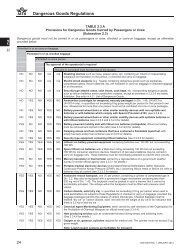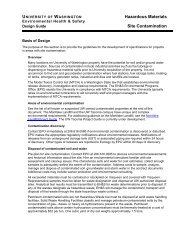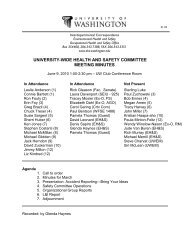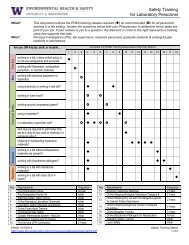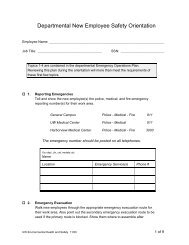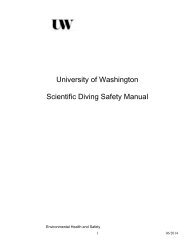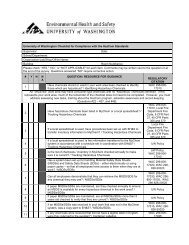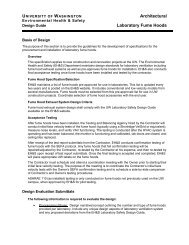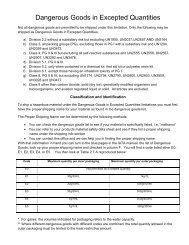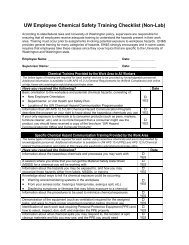Bloodborne Pathogens PowerPoint - Environmental Health and Safety
Bloodborne Pathogens PowerPoint - Environmental Health and Safety
Bloodborne Pathogens PowerPoint - Environmental Health and Safety
You also want an ePaper? Increase the reach of your titles
YUMPU automatically turns print PDFs into web optimized ePapers that Google loves.
The 8 th “AEGEAN AIRLINES PRO-AM”29 May – 01 June 2013, Costa Navarino, GreeceTEAM REGISTRATION FORMAmateur Pro-Am package includes:€1,650/golfer in Westin Single room€1,350/golfer in Westin Twin shared room with team member(€550*/non playing partner sharing a double room with a golfer)The Pro-Am package for amateurs includes:5 nights BB accommodation at Westin Resort, Costa Navarino2 Aegean Pro-Am rounds (1 day at The Dunes Course <strong>and</strong> 1 day at The Bay Course)1 Official practice round (1 day at The Dunes Course or 1 day at The Bay Course)Participation in the Aegean Cup 2013 – 1 round at The Bay CourseBus transfers (Kalamata airport to/from Hotel-transfers to/from Dunes & Bay)Golf balls for practiceBuggies for all roundsOn-course refreshments <strong>and</strong> snacks for 4 tournament roundsWelcome packWelcome receptionBarbeque eventGala dinner & Prize giving CeremonyLottery ticket for GalaPlayers liability <strong>and</strong> bodily injury insurance in the courseNot included in the package:Professionals:* Non-playing partner fee:Flights <strong>and</strong> others means of transportExtras at the hotel <strong>and</strong> its facilitiesThere is no Pro-Am package fee for each participating professional with a team of 3amateurs. Complimentary accommodation in a double room (no extras) is offered to eachparticipating professional (<strong>and</strong> spouse/partner) for 5 nights on BB basis at Westin Resort,Costa Navarino.Accompanying person fee applies to spouse/partner of each participating professional.Includes accommodation (shared double room with an amateur golfer) <strong>and</strong> participationin 3 social events.Final deadline for entries is April 15th, 2013.Entries will be allocated on a first come, first served basis. Places are limited to 60 teams.A team entry is considered valid only after full payment of the amateurs’ Pro-Am package fees.Amateurs are required to provide their exact h<strong>and</strong>icap on the entry form at the time of entry <strong>and</strong> will be asked to confirm their h<strong>and</strong>icap atthe registration desk of the event. Any amendments MUST be notified by 10.00hrs on Wednesday 29th May.All prize winners will be required to provide current proof of h<strong>and</strong>icap before their team is presented with their prizes.For those players who possess a "EGA/USGA" related h<strong>and</strong>icap, the slope system will apply to the tournament <strong>and</strong> each amateur will playfrom the applicable h<strong>and</strong>icap. Those players whose h<strong>and</strong>icap is not related to the "slope" system (CONGU) should provide their exact currenth<strong>and</strong>icap at their home club <strong>and</strong> this will be readjusted according to the calculation provided by the EGA to suit a “sloped” golf course.For more information about participation – registration details please visit our web site www.aegeanproam.comFor any participation inquires please contact the 8 th “Aegean Airlines Pro-Am” Event Organiser FREI S.A. at reg-aegeanproam@frei.grPlease fill in this Team Registration Form in CAPITAL LETTERS <strong>and</strong> tick where appropriate. You are kindly requested to send it by fax or e-mail tothe Event Organizer.
7 minutes - fill out Forms•Registration•Hepatitis B Vaccination• Need to fill out both forms <strong>and</strong> h<strong>and</strong> in atend of classEH&S UW <strong>Bloodborne</strong> Pathogen Training 2
<strong>Bloodborne</strong> <strong>Pathogens</strong>Training for ResearchersJudy Cashman, RNEH&S Research & Occupational <strong>Safety</strong>206-221-7770, ehsbio@uw.eduohnurse@uw.eduEH&S UW <strong>Bloodborne</strong> Pathogen Training 3
<strong>Bloodborne</strong> Pathogen (BBP)Rule• Washington Administrative Code(WAC) 296-823– Enacted in 1993– Safe sharps requirements in 2000(Needlestick <strong>Safety</strong> <strong>and</strong> Prevention Act)• Reduce risk of BBP exposure toworkers• Annual Training requiredEH&S UW <strong>Bloodborne</strong> Pathogen Training 5
UW BBP Program• All UW employees with a reasonablyanticipated potential for exposure to humansource materials, including human blood <strong>and</strong> itscomponents, human tissue, all human cell lines, as well asmedications derived from blood (e.g., immune globulins,albumin) <strong>and</strong> other potentially infectious materials (OPIM),are required to comply with the UW BBP Program.• Principal investigators (PIs)/supervisors areresponsible for assessing activities in the workplace <strong>and</strong>determining if employees have a potential for occupationalexposure.• Requirements of the UW BBP Program:– Developing a BBP Exposure Control Plan– Offering the hepatitis B vaccine– Training 6
BBP Statistics• In Washington, Labor & Industries (L&I) estimates~44,000 needlestick injuries per year• By Dec, 31, 2000, CDC reports:57 health care workers have seroconverted followingoccupational exposure to HIV– 25 have developed AIDS– 3 were lab workers working with concentrated virus– Percutaneous exposure was the most commonrouteEH&S UW <strong>Bloodborne</strong> Pathogen Training 7
Roles & Responsibilities• EH&S– Administer the UWBBP Program– Assist in obtaining theHepatitis B Vaccine– Provide BBP Training– Issue Biological UseAuthorization to labs– Consultation <strong>and</strong>Incident/accidentfollow-up investigationEH&S UW <strong>Bloodborne</strong> Pathogen Training 8
Roles & Responsibilities• Principal Investigator– ID hazards <strong>and</strong> who needs to be in the BBPProgram– Develop/review lab Exposure Control Plan– Provide personal protective equipment– Provide lab specific safety training– Enforce safety rulesEH&S UW <strong>Bloodborne</strong> Pathogen Training 9
Roles & Responsibilities• Staff (You)– Follow the exposure control plan– Wear required PPE– Ask questions– Suggest safer work practices/ procedures toyour PIEH&S UW <strong>Bloodborne</strong> Pathogen Training 10
How are Suggestions or changes to workpractices communicated?1. staff meetings2. email3. 1:14. suggestion box/other5. Don’t know/not sureEH&S UW <strong>Bloodborne</strong> Pathogen Training 11
Roles & Responsibilities• Employee <strong>Health</strong>Center– Provide clinicalservices– Administer hepatitis Bvaccine– Provide Post-exposurecounselingEH&S UW <strong>Bloodborne</strong> Pathogen Training 12
<strong>Bloodborne</strong> <strong>Pathogens</strong>• Microorganisms that are present in human blood <strong>and</strong>its components <strong>and</strong> can cause disease.• Human Immunodeficiency Virus (HIV) - AIDS• Hepatitis B virus (HBV) – Hepatitis B• Hepatitis C virus (HCV) – Hepatitis C• Brucella spp. (bacterium) – Brucellosis• Babesia (parasite) - Babesiosis• Treponema pallidum- Syphilis• Arboviruses- Viral hemorrhagic fever, West Nile Virus• Prions- Creutzfeld-Jakob Disease• Plasmodium spp. - MalariaEH&S UW <strong>Bloodborne</strong> Pathogen Training 13
Not Risk for BBP transmission• …unless you can SEE the blood inthem…but still h<strong>and</strong>le with caution.– Urine– Feces– Vomit– Sweat– Tears– SalivaEH&S UW <strong>Bloodborne</strong> Pathogen Training 15
Where will I go if I have aquestion about “OPIM”?• Check the Washington AdministrativeCode (WAC) 296-823• See the EH&S website:www.ehs.washington.edu/• Call Research <strong>and</strong> Occupational <strong>Safety</strong>:206-221-7770• Check the lab Biosafety ManualEH&S UW <strong>Bloodborne</strong> Pathogen Training 16
Transmission of BBPOccupational Exposure• Reasonably anticipated skin, eye, mucousmembrane, or parenteral (piercing of the skin)contact with blood or OPIM that may result fromthe performance of an employee's dutiesExposure Incident• is a specific contact with blood orOPIM that is capable oftransmitting a bloodborne diseaseEH&S UW <strong>Bloodborne</strong> Pathogen Training 17
BBP-Occupational Exposure• Skin– Needle sticks or contaminated sharpsinjuries– Open wound contamination: cut, rash,dermatitis, psoriasis• Mucous membrane exposure: eyes,nose, mouthEH&S UW <strong>Bloodborne</strong> Pathogen Training 18
Transmission Risk of BBPRisk of infection depends on several factors:Pathogen involvedType/route of exposureAmount of virus in infectedblood during exposureAmount of infected bloodinvolved in the exposureIf post-exposure treatmentwas takenSpecific immune response ofinfected individualCourtesy of Owen Mumford, Inc.EH&S UW <strong>Bloodborne</strong> Pathogen Training 19
Transmission Risk followingExposure to Infected BloodVirus# of virusparticles/ml of bloodHepatitis B 10 6 -10 13(Millions – trillions)Hepatitis C 10 6(Millions)HIV (AIDS) 10-10 3(Tens – thous<strong>and</strong>s)Risk of infectionfollowing parenteral(needlestick or cut)exposure1 in 3(30%)1 in 30(3%)1 in 300(0.3%)Source: Centers for Disease Control <strong>and</strong> Prevention20
Hepatitis B• Statistically thegreatest risk• 6-30% risk followingexposure incident(non-immunized)• Incubation period is 6weeks- 6 months(45-180 days)• 30-50% of infecteddevelop clinical illness• 0.5-1% of infecteddevelop rapid fatal liverdisease• 2-10% of infecteddevelop chronic activehepatitis-carrier state,infectious for life.• Very stable-persists atroom temp for 7days.EH&S UW <strong>Bloodborne</strong> Pathogen Training 21
Hepatitis C• Most common chronicbloodborne infection• 80% infected withoutsymptoms (CDC)• Incubation period 2weeks-6 months• ~16 hrs-4 days onsurfaces• No vaccineEH&S UW <strong>Bloodborne</strong> Pathogen Training 22
Hepatitis B <strong>and</strong> C Symptoms• jaundice• fatigue• loss of appetite• nausea• abdominal discomfort• dark urine• clay-colored stoolNormal eyesJaundiced eyesEH&S UW <strong>Bloodborne</strong> Pathogen Training 23
HumanImmunodeficiencyVirus (HIV)• Fragile – lives only a few hours outside thebody• Causes Acquired Immunodeficiency Syndrome(AIDS)• AIDS allows development of opportunisticdisease, which ultimately causes death.• A flu-like illness can occur 1-6 weeks afterexposure to the virus:-Fever, sweats, malaise, muscle pains, nausea, diarrhea,• Enlarged lymph nodes, mycological oralinfections, fatigue, weight loss• Symptom-free period of 5-10 years can occurEH&S UW <strong>Bloodborne</strong> Pathogen Training 24
What is the most common routeof exposure to BBP in theworkplace?1. Injury from contaminatedneedlesticks <strong>and</strong>/or sharps2. Eye <strong>and</strong> mucous membrane exposure3. Open wound contamination (cut,dermatitis, psoriasis)EH&S UW <strong>Bloodborne</strong> Pathogen Training 25
Exposure Control Plan (ECP)• Must include BBP st<strong>and</strong>ardhttp://www.lni.wa.gov/wisha/Rules/bbpathogens/default.htm• Biosafety Manual containsUW Core ECP, in Section IX• See online athttp://www.ehs.washington.edu/rbsbiosafe/bsmanualindex.shtmEH&S UW <strong>Bloodborne</strong> Pathogen Training 26
Exposure Control Plan1. Exposure Determination2. Method of Compliance orimplementation3. Hepatitis B vaccination, Post-Exposure evaluation <strong>and</strong>follow-up4. Communication of Hazardsto employees5. Record keepingEH&S UW <strong>Bloodborne</strong> Pathogen Training 27
Exposure Control Plan1. ExposureDetermination:• By job classification• By tasks <strong>and</strong>procedures• Withoutconsideration ofPPE wornEH&S UW <strong>Bloodborne</strong> Pathogen Training 28
Exposure Control Plan2. Control Employee Exposure:• Universal precautions• Engineering controls• Work practices• Personal Protective EquipmentEH&S UW <strong>Bloodborne</strong> Pathogen Training 29
ECP- Universal Precautions• Blood <strong>and</strong> OPIMALWAYS consideredinfectious• Appropriate barriers <strong>and</strong>procedures must beused when contact withblood or OPIM isanticipatedEH&S UW <strong>Bloodborne</strong> Pathogen Training 30
ECP-Engineering ControlsTOOLS toPreventExposureBiological <strong>Safety</strong> Cabinet(BSC)EH&S UW <strong>Bloodborne</strong> Pathogen Training 31
Safe BSC Use Video:Proper Use of a Biological <strong>Safety</strong> Cabinet (SD – 2002)An excellent review of safe BSC work practices covering preplanning,PPE, cabinet preparation, work practices, spills, <strong>and</strong>post process steps.NOTE! There are three differences for BSC work at the UW.‣ Important: Sharps are not prohibited in BSCs at the UW.‣ Water can be used after the decontaminating bleach <strong>and</strong> isrecommended by Baker for their BSCs.‣ Good h<strong>and</strong> washing is more about sudsing soap <strong>and</strong>scrubbing for at least 20 seconds than the use ofgermicidal soap.http://vimeo.com/groups/34691/videos/7642083EH&S UW <strong>Bloodborne</strong> Pathogen Training 32
ECP-Engineering Controls• Centrifuge <strong>Safety</strong>Features– Receive training– <strong>Safety</strong> cups/buckets or O-ring– When in Biosafety Cabinet (BSC)place at rear, don’t performother work while running– Wait 5 minutes to unload– Stop immediately for unusualvibration or noise <strong>and</strong> notifysupervisor– Ensure proper balancing– Do not overfillEH&S UW <strong>Bloodborne</strong> Pathogen Training 33
ECP-Engineering Controls• Safer Medical Devices– Needleless systems– Sharps with engineeredsharps injury protections(SESIP)– Self-blunting needles– Plastic capillary tubes– Exemptions for saferneedle requirements, ifnot using theseUnprotected positionProtected positionExample of needle guard with protectedsliding sheath that is pushed forward afteruse <strong>and</strong> locks (with some designs the shieldmust be twisted to engage the lock).EH&SUW <strong>Bloodborne</strong> Pathogen Training34
ECP-Engineering ControlsSharps disposal containers- Closable- Puncture-resistant- Leak-proof- Labeled or color-coded- Upright, conveniently placedin area where sharps used- DO NOT OVERFILL!EH&S UW <strong>Bloodborne</strong> Pathogen Training 35
Sharps Containers withProblemsEH&S UW <strong>Bloodborne</strong> Pathogen Training 36
ECP-Work Practice ControlsKey ConceptPerform alltasks in amanner thatreducesspraying,splashing oraerosolization.EH&S UW <strong>Bloodborne</strong> Pathogen Training 37
ECP-Work Practice ControlsH<strong>and</strong>le sharps safely to minimize exposure toblood or OPIM:‣ Don’t recap or removeneedles‣ Don’t bend, shear or breakneedles‣ Place contaminated reusablesharps immediately inappropriate containers untilproperly decontaminatedEH&SUW <strong>Bloodborne</strong> Pathogen Training38
EH&SUW <strong>Bloodborne</strong> PathogenTraining39
More Tips on Safe Sharps H<strong>and</strong>ling‣ Know what Sharps include:http://www.ehs.washington.edu/rbsresplan/sharp.shtm(needles, IV tubing with needles attached,scalpel blades, lancets, syringes that have beenremoved from their original sterile containers, <strong>and</strong>glass tubes that could be broken during h<strong>and</strong>ling)‣ Develop <strong>and</strong> implement specific policies for safeh<strong>and</strong>ling:http://safeneedle.org/us-needlesticks/preventingneedlestick-injuries-a-checklist/‣ Do not h<strong>and</strong>le broken glassware directly by h<strong>and</strong>9/17/2012 EH&S UW <strong>Bloodborne</strong> Pathogen Training
ECP-Work Practice Controls• H<strong>and</strong> washing• No food/cosmetics• No mouth pipetting• Dispose of gloves after useEH&S UW <strong>Bloodborne</strong> Pathogen Training 41
ECP-Work Practice Controls• Remove gloves safely <strong>and</strong>properly– Grasp near cuff of glove <strong>and</strong>turn it inside out. Hold in thegloved h<strong>and</strong>.– Place fingers of bare h<strong>and</strong>inside cuff of gloved h<strong>and</strong> <strong>and</strong>also turn inside out <strong>and</strong> overthe first glove.– Dispose gloves into properwaste containerDEMO of GLOVE REMOVAL:https://depts.washington.edu/ehas/pubcookie/train/bbpx/bbp6a.phpEH&S UW <strong>Bloodborne</strong> Pathogen Training 42
ECP-Work Practice Controls• Written cleaning <strong>and</strong>decontamination schedule<strong>and</strong> procedures• Decontamination Agents:– Bleach 1:10– EPA certified agent (alcoholis not)– Quaternary Compounds– Premixed:• Environcide• clavicide• Contact time is criticalEH&S UW <strong>Bloodborne</strong> Pathogen Training 43
ECP- Work Practice Controls• Decontamination1. Place absorbent material atopspill, sufficiently spray/coverentire area. Some start at theedges <strong>and</strong> work in, others justcover the area.2. You want to ensure that youcover the contaminated area.SPILLS VIDEO:https://depts.washington.edu/ehas/pubcookie/train/bbpx/bbp7.phpEH&S UW <strong>Bloodborne</strong> Pathogen Training 44
ECP-Work Practice ControlsRegulated Waste• Close immediately beforeremoving or replacing• Place in second container ifleaking possible or if outsidecontamination of primarycontainer occurs• Contaminated equipment musthave biohazard sign attachedinformsupervisorBIOHAZARDOUS WASTE, incl. Flow Chartshttp://www.ehs.washington.edu/ohsreslab/biowaste.shtmEH&SUW <strong>Bloodborne</strong> Pathogen Training45
ECP- Signs <strong>and</strong> Labelshttp://www.ehs.washington.edu/rbsbiosafe/postbz.shtmEH&S UW <strong>Bloodborne</strong> Pathogen Training 46
Precautions required whentransporting blood• Put in secondary leakproof container– Plastic ziplock, or styrofoam• If in a Biohazard container or other designatedcontainer, don’t need label– Consider where the sample will travel(the end user)More information on EH&S websitehttp://www.ehs.washington.edu/rbsbiosafe/appendixb.pdfEH&S UW <strong>Bloodborne</strong> Pathogen Training 47
ECP-Personal ProtectiveEquipment (PPE)Type <strong>and</strong> amount of PPE requireddepends on the task <strong>and</strong> anticipatedexposure.– Must not permit blood or OPIM topass through or reach outer orinner clothing, mucous membranesor skin.– If clothing becomes contaminated,immediately remove it.– Must be removed prior to leavingthe work area. PPE must not beworn in common areas.– Provided at no cost to employee.Nitrile gloves for alcohol. EH&SUW <strong>Bloodborne</strong> Pathogen Training48
ECP-LaundryFor Contaminated articles:– H<strong>and</strong>le as little as possible• Bag/contain where used• Don’t sort or rinse where used• Place in leak-proof, labeled orcolor-coded containers or bags– Wear PPE when h<strong>and</strong>ling <strong>and</strong>/orsorting• Gloves• GownEH&S UW <strong>Bloodborne</strong> Pathogen Training 49
ECP-Medical Management3. Medical Managementa. Hepatitis B vaccineb. Post exposureevaluationc. Follow-upEH&S UW <strong>Bloodborne</strong> Pathogen Training 50
ECP- Medical ManagementHepatitis B Vaccine• Must be offered within 10 days of initialassignment• 3 injections at 0, 1, 6 months• Check titer 1-2 months after series• 96-99% effective• No boosters needed• Call your Employee <strong>Health</strong> Center for anappointment – FREE – During work hoursEH&S UW <strong>Bloodborne</strong> Pathogen Training 51
Hepatitis B Vaccine form• Needs to be filled out unless you havealready done so in the past• If you have had vaccinations, checkthe line stating this, put in date oryear• If you decline the vaccination, checkthis line, sign <strong>and</strong> dateEH&S UW <strong>Bloodborne</strong> Pathogen Training 52
ECP-Medical ManagementWhat to do if exposed?1. DO First Aid• Parenteral (break through skin):Immediately thoroughly washwound with sudsing soap <strong>and</strong>water—for 15 minutes.• Mucous Membrane: Immediatelythoroughly flush mucousmembrane with water for 15minutes.2. GET Medical HelpEH&S UW <strong>Bloodborne</strong> Pathogen Training 53
ECP-Medical ManagementHow to Get Medical Help?• Call UW Employee <strong>Health</strong> Center at 206-685-1026– Harborview Sites: 206-744-3081• After hours or clinic is closed, go to nearestEmergency Room (ER)• Call 911EMERGENCY POSTER:http://www.ehs.washington.edu/manuals/posters/ehsexposureresponseposter.pdfEH&S UW <strong>Bloodborne</strong> Pathogen Training 54
ECP-Medical Management:Post Exposure Evaluation• Document exposureincident <strong>and</strong> ID source• Testing <strong>and</strong> Post-Exposure treatment• Counseling• Evaluation <strong>and</strong> follow-upEH&S UW <strong>Bloodborne</strong> Pathogen Training 55
<strong>Health</strong> Care ProfessionalWritten Opinion<strong>Health</strong> Care Professional’s Written O pinion For Post - Exposure EvaluationUse with Chapter 296 - 823 WAC, Occupational Exposure to <strong>Bloodborne</strong> <strong>Pathogens</strong>Employee’s Name:Date of Incident: tDate of Evaluation:<strong>Health</strong> Pro fessional’s Address:<strong>Health</strong> Professional’s Telephone:________________________________________________________________________________________________________________________________________________________________________________________________________________________________________ The employee named above has been in formed of the results of the evaluation forexposure to blood or other potentially infectious materials.____The employee named above has been told about any health conditions resultingfrom exposure to blood or other potentially infectious materials whi ch require furtherevaluation or treatment.____ Hepatitis B vaccination is ____ is not ____ indicated.Employeeto receivewithin 15days________________________________<strong>Health</strong> Care Professional’s Name_____________________________________________________________<strong>Health</strong> Care Professio nal’s Signature DateReturn this form to the employer <strong>and</strong> provide a copy to the employee within 15 days.Please label the outside of the envelope “Confidential.”Employer’s NameEmployer’s Address :_______________________________________________________________________________________________________________________________________Confidential Fax: _________________ _______________________________EH&S UW <strong>Bloodborne</strong> Pathogen Training 56
ECP- Hazard Communication4. HazardCommunication• Annual UW BBPtraining• Laboratory specifichazards training• Exposure ControlPlan – annual reviewEH&S UW <strong>Bloodborne</strong> Pathogen Training 57
ECP-Records5. Record Keeping• Training records- EH&S<strong>and</strong> PI- keep 3 years• Medical records-kept atEmployee <strong>Health</strong> Centerfor duration ofemployment plus 30 years• You &/or Supervisor fill outthe OARS (online) reportafter incident-EHSEH&S UW <strong>Bloodborne</strong> Pathogen Training 58
Additional RequirementsHIV/HBV/HCV Research Labs• Lab specific biosafety manual-reviewed annually• Special Practices– Labs doors closed when working with virus– No bench work/must use BSC– Limited needle/syringe use– Limited access only to those aware of hazards– PPE in labs—NOT to be worn outside lab,decontaminated before laundered.• Training– Demonstrated proficiency-microbiologicalpractices <strong>and</strong> practices <strong>and</strong> operations specific tothe facility BEFORE work w/virus.EH&S UW <strong>Bloodborne</strong> Pathogen Training 59
Resources• International Sharps Injury Prevention Society(ISIPS): http://www.isips.org/• WA State Department of <strong>Safety</strong> <strong>and</strong> <strong>Health</strong> BBPpage:http://www.lni.wa.gov/<strong>Safety</strong>/Topics/AtoZ/BB<strong>Pathogens</strong>/default.asp• Centers for Disease Control <strong>and</strong> Prevention(CDC) Biosafety in Microbiological <strong>and</strong>Biomedical Laboratories (BMBL)website:http://www.cdc.gov/OD/ohs/biosfty/bmbl5/bmbl5toc.htmEH&S UW <strong>Bloodborne</strong> Pathogen Training 60
Resources• EH&S Site-Specific Exposure Control Plan:http://www.ehs.washington.edu/forms/rbs/researchlaboratorysupplementalform.doc• Specimen H<strong>and</strong>ling Transport EH&S Class:http://www.ehs.washington.edu/eposhiphazmat/index.shtm• EH&S Research <strong>and</strong> Occupational <strong>Safety</strong>:206-221-7770, ehsbio@uw.edu,http://www.ehs.washington.edu/rbs/bbp.shtmEH&S UW <strong>Bloodborne</strong> Pathogen Training 61
QUESTIONS?Be sure to look at your workplaceExposure Control Plan!See you next year… online!"I hear & see - I learn, but may forget,But if I do, I underst<strong>and</strong>."EH&S UW <strong>Bloodborne</strong> Pathogen Training 62



